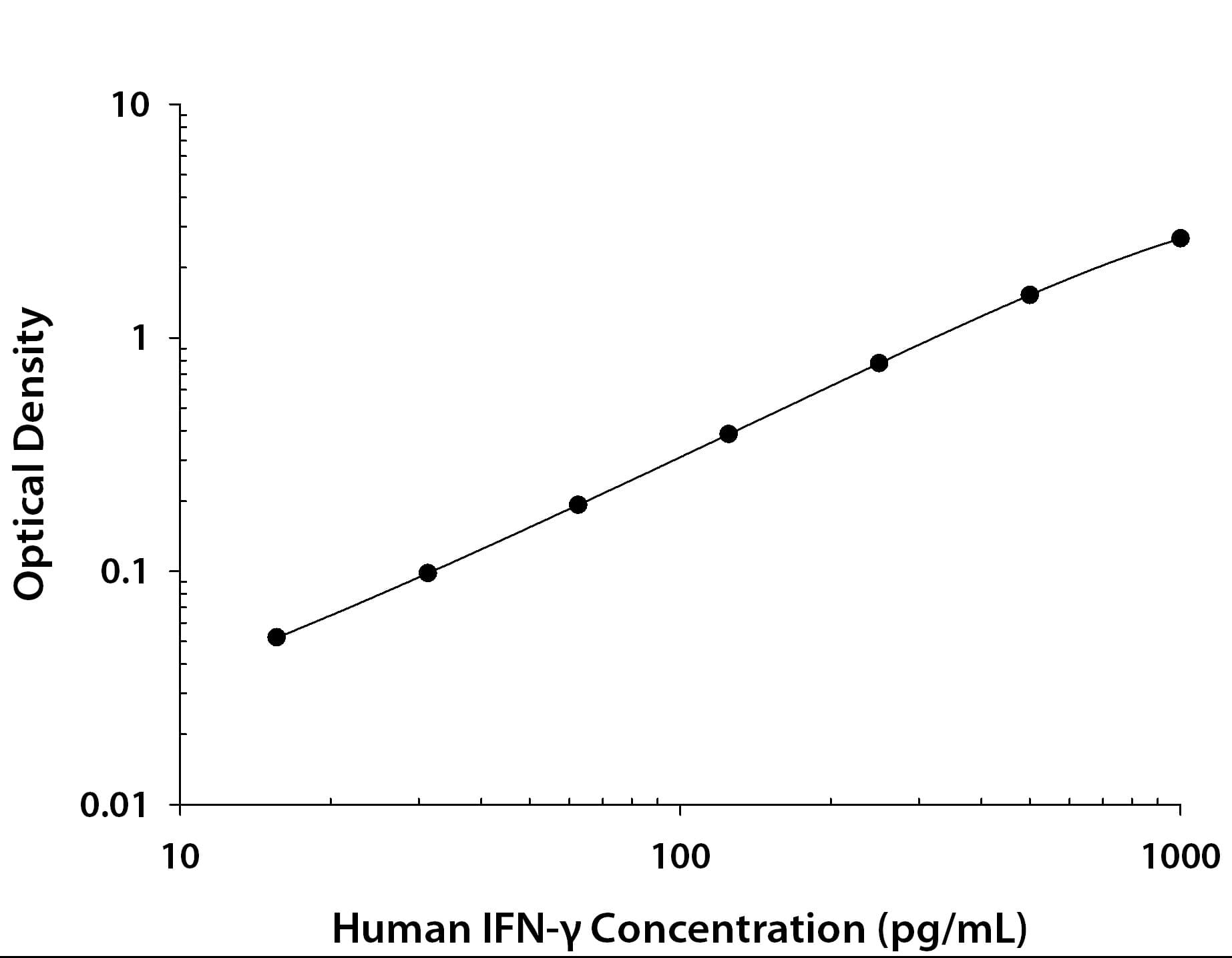 全部商品分类
全部商品分类



 下载产品说明书
下载产品说明书 下载SDS
下载SDS 用小程序,查商品更便捷
用小程序,查商品更便捷


 收藏
收藏
 对比
对比 咨询
咨询Sample Values
Serum/Plasma - Thirty samples from apparently healthy volunteers were evaluated for the presence of human IFN-gamma in this assay. No medical histories were available for the donors used in this study. All samples measured less than the lowest human IFN-gamma standard, 15.6 pg/mL.| Condition | (pg/mL) |
| Unstimulated | ND |
| Stimulated with PHA | 78,480 |
| Condition | (pg/mL) |
| Untreated | ND |
| Stimulated with CD3/CD28 antibodies | 49,500 |
| Stimulated with Cloudz T cell activation kit | 186,800 |
Precision
Cell Culture Supernates, Serum, EDTA Plasma, Heparin Plasma
| Intra-Assay Precision | Inter-Assay Precision | |||||
|---|---|---|---|---|---|---|
| Sample | 1 | 2 | 3 | 1 | 2 | 3 |
| n | 20 | 20 | 20 | 20 | 20 | 20 |
| Mean (pg/mL) | 153 | 366 | 720 | 154 | 366 | 723 |
| Standard Deviation | 3.47 | 9.16 | 19.4 | 9.9 | 20.6 | 54 |
| CV% | 2.3 | 2.5 | 2.7 | 6.4 | 5.6 | 7.5 |
Recovery
The recovery of human IFN-gamma spiked to levels throughout the range of the assay in various matrices was evaluated.
| Sample Type | Average % Recovery | Range % |
|---|---|---|
| Cell Culture Media (n=4) | 91 | 84-106 |
| EDTA Plasma (n=4) | 95 | 85-105 |
| Heparin Plasma (n=4) | 96 | 87-101 |
| Serum (n=4) | 95 | 90-109 |
Linearity
Scientific Data
Human IFN-gamma Quantikine ELISA Kit Summary

Background: IFN-gamma
Interferon-gamma (IFN-gamma ) is an important immunomodulatory cytokine, affecting both the innate and adaptive immune systems. It was discovered in 1965 as a soluble anti-viral factor and has since been shown to promote host defense against a wide variety of pathogens (1, 2). Additionally, it has been shown to promote autophagy and apoptosis, and to have anti-proliferative, anti-angiogenic, and anti-tumorigenic properties (1, 3, 4). IFN-gamma is primarily secreted by natural killer (NK) cells (5-7), activated CD8+ T cells (8), Th1 CD4+ T cells (9), NKT cells (10, 11), and macrophages (12-16), but it has also been shown to be produced by a number of other cell types including dendritic cells (17), gamma δ T cells (18), group 1 ILCs (19), keratinocytes (20), neutrophils (21), mast cells (22), and neurons (23).
The biologically active form of IFN-gamma is a non-covalently linked homodimer (24), which binds with high affinity to IFN-gamma R1/CD119 and subsequently recruits IFN-gamma R2 to form the functional heterotetrameric receptor complex. Formation of this complex leads to phosphorylation and activation of the Janus kinases, Jak1 and Jak2, which in turn phosphorylate and activate STAT1. STAT1 homodimerizes and translocates to the nucleus where it binds to IFN-gamma -activated sequence (GAS) elements in the promoters of target genes to regulate their transcription. Many of the IFN-gamma /STAT1 target genes are transcription factors that then drive the expression of secondary response genes. Additionally, IFN-gamma signaling has been shown to activate MAPK, PI 3-K/Akt, and the NF-kappa B signaling pathways, leading to the expression of multiple other genes. IFN-gamma signaling plays a key role in host defense by promoting macrophage activation, upregulating the expression of antigen processing and presentation molecules, driving the development and activation of Th1 cells, enhancing natural killer cell activity, regulating B cell functions, and inducing the production of chemokines that promote effector cell trafficking to sites of inflammation.
Due to its immunoregulatory activities, IFN-gamma has been used as a therapeutic agent for treating a range of bacterial, fungal, helminth, protozoan, and viral infections, immunodeficiency syndromes, multi-drug resistant tuberculosis (MDR-TB), and sepsis (1, 25-34). Additionally, it has been used as an anti-tumor agent to improve patient survival in a number of different types of cancer due to its pro-apoptotic and anti-angiogenic effects (3, 35). In contrast, IFN-gamma has been suggested to be involved in the progression of cardiac diseases as elevated levels of this cytokine have been detected in the serum of patients with chronic heart failure, as well as in atherosclerotic lesions and in myocardial tissues of patients with Chagas' cardiomyopathy (1, 36, 37). Similarly, high levels of IFN-gamma have been found in the serum and/or cerebrospinal fluid of patients with neurodegenerative diseases such as Amyotrophic lateral sclerosis and Parkinson's disease (38, 39), suggesting that IFN-gamma may also be involved in neurodegenerative disease progression and serve as a clinical biomarker. Additionally, there is recent evidence suggesting that IFN-gamma may also have context-dependent proliferative and pro-tumorigenic effects (3).







